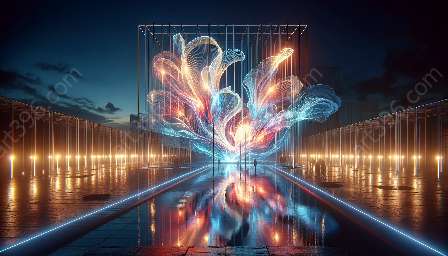Introduction to Light Art
Light art, also known as luminism or luminist art, is a form of visual art where the primary medium of expression is light. Through the use of various light sources such as natural light, artificial light, and LED installations, light artists create captivating and transformative experiences that challenge traditional notions of art and aesthetics. Light artists manipulate and mold light to create immersive and interactive installations that engage viewers in new and innovative ways.
The Challenge to Traditional Notions of Art and Aesthetics
Light art challenges traditional notions of art and aesthetics on multiple fronts. Firstly, by using light as the primary medium, light artists break free from the constraints of conventional canvas or sculpture-based art forms. This departure from traditional mediums allows for a more dynamic and multi-sensory experience, blurring the boundaries between art and the surrounding environment.
Furthermore, traditional art has often been associated with permanence and immutability. However, light art defies these conventions by being inherently transient and ephemeral. As light is fleeting and subject to change, the artworks created using light exist in a state of flux, continuously evolving and responding to the environment around them. This impermanence challenges the traditional notion of art as a static and unchanging entity.
Interactivity in Light Art
Interactivity plays a pivotal role in light art, further challenging traditional notions of art. Unlike traditional art forms that are often observed passively, light art encourages active participation and engagement from the audience. Viewers are invited to interact with the artwork, often becoming integral components of the overall experience. This active involvement transforms the viewer from a passive spectator into an active participant, blurring the line between the creator and the observer.
Moreover, advancements in technology have enabled the integration of interactive elements in light art installations. Interactive light art installations respond to the movements, gestures, and presence of the viewers, creating a dynamic and personalized experience for each participant.
Transformation and Innovation
Light art embodies transformation and innovation, pushing the boundaries of traditional art and aesthetics. Through the use of light, artists can manipulate space, perception, and emotion in unprecedented ways. The transformative nature of light art challenges viewers to reconsider their preconceived notions of art and beauty, often eliciting emotional and intellectual responses that transcend conventional artistic experiences.
Additionally, the compatibility of interactivity in light art further enhances the transformative qualities of these artworks. By allowing viewers to actively engage with and influence the artwork, light art creates an environment of co-creation and dynamic exchange, fostering a sense of participation and ownership among the audience.
Conclusion
Light art represents a paradigm shift in the art world, challenging traditional notions of art and aesthetics through its dynamic, immersive, and interactive nature. By embracing impermanence, interactivity, and innovation, light art paves the way for a new era of artistic expression that transcends the boundaries of traditional art forms. The transformative and captivating qualities of light art invite viewers to explore, engage, and contemplate the ever-evolving relationship between light, art, and aesthetics.

